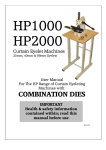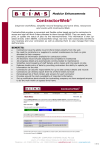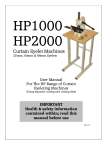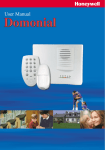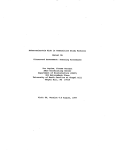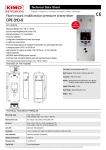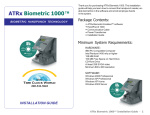Download HP1000 Full Instructions (MkII combi dies)
Transcript
WARNING! Health and Safety information contained within. PLEASE NOTE! Incorrect set-up can damage this equipment. READ THIS MANUAL User Manual HP1000c Curtain Eyelet Machine Combination Tools (mkII) Up to 40mm Curtain Eyelets Separate V-Cutter & Setting Tools Up to 66mm Curtain Eyelets March 2014 1 BASIC MACHINE SETUP FOR FIRST USE. Remove the machine and other parts from the packaging, In addition to this booklet and the setting tools you have ordered the following is also included: 1. 2. 3. 1 x HP1000 Press body 1 x Lever handle with silicone rubber grip 1 x Base plate with back stop and eyelet distance regulator 2 x hexagon keys (5mm and 6mm) 1 x M8 cap screw 2 x M6 cap screws 2 x M6 washers Tool pack 4. 5. 6. 7. 8. Fig 1 1 Tool Pack 3 7 6 2 5 4 Before use, this equipment must be securely bolted to a suitable bench using the fixing holes at the rear of its base Fig 2 The HP1000 machine cannot be operated without being first being bolted down to a suitable work bench. If you have purchased our self-assembly bench with this machine then please assemble this first and bolt the HP1000 to it using the nuts and bolts that are supplied with the bench. Alternatively, fasten the machine to a suitably solid bench by drilling through the top surface and bolting the HP1000 to it securely using good quality fixings. If you do not fasten the machine down in one of the above methods, then it will not cut material or set the eyelets. It will also want to tip forward potentially injuring the operator! Fig 3 Fig 4 Rack Fig 5 Pinion 7cm Rotate the pinion to lift the rack up (use the lever handle if it is too stiff) until it is about 7 cm’s (3”) above the base. Insert the lever handle in to the pinion from the front of the HP1000 and use the M10 cap screw in the end of the pinion to secure in position. Rotate the lever handle right round to the back of the machine to the safe position. Fix the base plate to the machine body using the 2 x M6 cap screws and washers The HP1000 is now ready for the tool setup 2 MACHINE USE This machine allows the user to insert eyelets in their chosen material. By changing the tools (see fig 6) different size eyelets can be fitted. Depending on your order requirements this machine will have been supplied with either combination type tools that both cut the material and fit the eyelet in one sequence without the need to change the tools (see Fig 6) or separate V-cutter and setting tools (see Figure 7). This manual describes and illustrates the setup and operation procedure to insert 40mm curtain eyelets using a HP1000 Eyelet Machine using the combination tools; the process is the same for all sizes of eyelet when using combination tools. Alternate instructions are available if you are using separate V-cutter & Setting tools in Appendix A at the back of this manual. Fig 6 Fig 7 Top Tool RETAINING SCREW Separate V-Cutter & Setting Tools (See Appendix A for setup and operation) TOP TOOL Bottom Tool SPIGOT BOTTOM TOOL BASE PLATE Bottom Tool RETAINING SCREW IMPORTANT SAFETY INFORMATION • • • • • Be aware that there are sharp cutting edges on the tools Keep hands away from tools when applying pressure. We advise that when using any machinery suitable gloves and eye protection should be worn. Follow the setup routines explained in this manual before first use Always follow maintenance routines explained in the maintenance section. Fig 8 THE SAFE POSITION Ensure the operating arm is fully rotated to the rear of the press to prevent it falling forward before changing or adjusting toolage or placing material and eyelets for setting. 3 SETTING UP AND USE THE MATERIAL LOCATION STOPS Fig 9 This machine is supplied with material location stops that assist the operator to accurately position the eyelets in the material . The back stop sets the distance from the top of the curtain, while the side stop controls the distance between each of the eyelets. The distance can be set between 10cm and 25cm centres. This is achieved by setting the side stop to the desired distance then placing the previously set eyelet over this pin while the next hole is cut. BACK STOP SIDE STOP BASE PLATE Fig 10 It is recommended that the operator practices with some waste material first to prevent errors in calculating the position of the eyelets. As an alternative, you can use the back stop on its own, and mark the position of the eyelets with pins. However please ensure that any pins are removed from the material before cutting as they will damage the tools. Keep the top of the curtain against the back stop Fig 11 Depending on the preference of the operator the base plate can be configured so the side stop is on either the left or the right hand side of the machine. The back stop and bottom tool retaining screw can easily be repositioned. 4 COMBINATION TOOLS - INSTALLATION OF THE TOOLS A Step 1 - Fit the bottom tool in to the base of the machine and tighten the retaining screw. Ensure the tool is sat flat on the base. Step 2 - Fit the top tool in to the column & tighten the retaining screw. Ensure the tool is flat against the underside of the column. DO NOT OVER TIGHTEN AS THIS WILL DAMAGE THE SETTING TOOLS IMPORTANT Step 3 - The tools must now be centralised. To do this, loosen the two screws (A) on either side of the bottom tool so that the baseplate is able to move freely. DO NOT OVER TIGHTEN AS THIS WILL DAMAGE THE TOOLS Step 4 - Gently lower the top tool on to the bottom tool spigot so that the two parts fit together, move the tool base plate so that the cutting edges of both tools can align Step 5 - ...then while maintaining pressure with the handle, retighten the base plate screws If this centralisation step is not carried out correctly it will lead to a damaged cutting edge! Finally lift the top tool clear and then re-lower to make sure the tools are correctly aligned; they should close and open smoothly without bumping or deflecting off one another. It is important to do these steps each time the tools are changed or when any other part of the machine is adjusted! 5 COMBINATION TOOLS - OPERATION OF THE MACHINE Step 1 - After aligning the tools as shown on the previous page, Place a backing ring with its spikes facing upwards on to the bottom tool (it should locate in a recess) Step 2 - ...Place the material in the desired position where you want the eyelet over the bottom tool and ring, the material should be face side up. Lower the top tool on to the material and apply firm pressure until it cuts the material then lift the top tool clear….. Step 3 - ……take an eyelet and sit it over the bottom tool spigot that is now visible through the material…. Step 4 - ...Lower the top tool down until it makes contact with the eyelet then apply firm pressure with the lever to cause the eyelet to push through the material and roll around the ring….. Step 5 - ..Lift the top tool clear of the base tool to release the fitted eyelet from the tools. Step 6 - Inspect the eyelet to ensure it has correctly rolled and firmly gripped the material. (If necessary, you can re-apply pressure if the eyelet is still loose) As you cut the holes, waste material will collect within the body of the top tool, use the hexagon key supplied to push this waste material out by inserting it in the small hole on the top tool. If waste material is allowed to build up in the top tool it will affect the ability of the tools to set the eyelet. Step 7 - Simply repeat these steps for each eyelet in the curtain. You can use the side stop to space the eyelets or mark their position in advance. 6 MAINTENANCE Fig 25 B A F C To ensure accuracy and the long life of the tools, the rack (A) must not be allowed to become slack; before use, always check there is no sideways movement (front to back (B) or left to right (C)) in the rack; if there is, tighten the 4 adjusting screws (D) on the front and side of the machine. Then tighten the locking nuts (E) to prevent the adjusting screws becoming loose The handle should be able to be rotated easily but remain at any position when not supported. Oil points marked (F) regularly, but do not over oil as this may cause drips onto your fabric. E D B C If you are unsure about any aspect of the set-up and operation or maintenance of this machine then please contact your supplier. NOTES: 7 Appendix A Inserting eyelets with the Separate V-Cutter & Setting Tools This section covers the slightly different method of fitting eyelets with the separate V-Cutter & Setting Tools as shown right. Tool Locator Top Setting Tool Although suitable for the vast majority of materials, certain types of material do not lend themselves to being cut using the combination type tools as illustrated in the main part of the manual. Some voils, silks and certain heavy duty theatrical blackout materials can snag and pull threads when cut. V-Cutter Cutting Ring In this situation pre-cutting the hole with a V– cutter will illuminate this problem in most cases. Bottom Setting Tool SETTING UP AND USING THE V-CUTTER A Step 1 - Fit the tool locator in to the base plate of the HP1000 and tighten the retaining screw. Then place the cutting ring over the tool locator Step 2 - Insert the v cutter in to the column & tighten the retaining screw Step 3 - The tools must now be centralised. To do this, loosen the two base plate screws on either side of the bottom tool (A) so the base plate can move Step 4 - Gently lower the V-cutter until it makes contact with cutting ring and centralises, then retighten the base plate screws. If this centralisation step is not carried out correctly it will lead to a damaged cutter! Step 5 - Place the material over the cutting ring in the desired position, lower the V-cutter down until it makes contact. Then apply firm pressure to cut the material. As it cuts it should make a firm click noise. Step 6 - Repeat to make further holes as desired along the length of your material. As you cut the holes, the waste material will collect in the cutting ring; periodically lift the ring off the spigot and remove this material to maintain effectiveness. 8 SETTING UP AND USING THE SETTING TOOLS Step 1 - Remove the V-cutter and replace Step 2 - Place a backing ring with its spikes it with the top setting tool. facing upwards on to the bottom setting Lift the cutting ring off the tool locator and tool. replace that with the bottom setting tool. Step 4 - Take an eyelet and sit it on the bottom setting tool, try not to trap any material between the eyelet and the bottom setting tool. Step 3 - Place the material on the machine and locate the one of the holes that you have just cut over the bottom tool with the material face side up. Step 5 - Lower the top setting tool down Step 6 - Lift the top setting tool up to reuntil it makes contact with the eyelet then veal the set eyelet apply firm pressure with the lever to cause the eyelet to push through the material and roll around the ring. The cutting ring has two cutting edges, when one side becomes blunt simply turn the ring over and use the other side. Step 7 - Inspect the eyelet to ensure it has correctly gripped the material. If necessary put the eyelet back on the machine and apply more pressure to achieve a tighter grip. When both sides have become blunt they can be re-sharpened this is best done by returning them to your supplier 9









